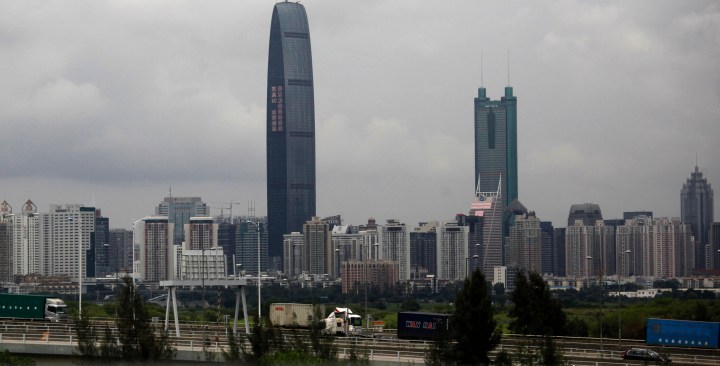Business Maverick, Newsdeck
Shenzhen’s ‘mini-Hong Kong’ to test China’s financial ambitions

China's southern boomtown of Shenzhen, a pioneer of economic reforms but long in the shadow of Hong Kong, is plotting another bold ploy: a $45 billion 'mini-Hong Kong' to return it to the limelight and aid China's rise as a financial power. By Alison Leung and James Pomfret.
On a barren stretch of reclaimed land in western Shenzhen and near the Hong Kong border, China wants to build another financial services hub from scratch in the Qianhai Bay economic zone, offering the low taxes, rigorous legal regime and anticorruption vigilance enjoyed by its affluent neighbour.
For the former British colony, which this weekend will mark the 15th anniversary of its return to China, the project could bring fresh business opportunities and bolster its position as China’s financial window on the global markets.
But Shenzhen’s ambitions are running into the brick wall of Beijing’s caution over reform, as China’s grand hopes of becoming a global financial powerhouse struggle to overcome its fear of freeing markets from government control.
Local officials have given up, for example, on the idea of an independent antigraft body similar to Hong Kong’s, settling for a hybrid that mixes features of the Hong Kong and mainland systems, said Cao Hailei, head of the Qianhai Authority overseeing the project.
“The structure of the two governments is different,” Cao told Reuters in an interview at a Shenzhen municipal government office.
Chinese President Hu Jintao is expected to announce preferential tax rates and other incentives for the Qianhai Bay zone when he visits Hong Kong this week to fete the anniversary of the city’s return and swear in a new administration.
China has been steadily expanding the role Hong Kong plays in internationalising the yuan, which it hopes one day will be a global currency like the dollar, and in building up the Chinese financial markets.
Beijing announced a series of new measures on Wednesday for Hong Kong, including allowing joint ventures among the stock exchanges of Shanghai, Shenzhen and Hong Kong, and letting Hong Kong financial firms set up consumer arms in Guangdong province, which includes Shenzhen.
BUCOLIC BACKWATER
Now a bustling metropolis of 10 million crammed with ports and skyscrapers and home to Chinese corporate goliaths such as carmaker BYD Co and telecommunications firm Huawei Technologies, Shenzhen was no more than a bucolic backwater of 30,000 villagers living off paddy fields and the sea in 1980.
Shenzhen’s stock market, while smaller than its Shanghai counterpart, has become the most active global IPO centre on a wave of domestic listings, eclipsing London and Hong Kong.
China has also laid out plans to build up Shanghai, which already boasts the world’s fourth-largest stock market by value of shares traded, into a bona fide global financial centre by 2020, but it still has far to go to compete broadly with established centres such as New York and London.
Despite giant economic strides in the past two decades, China’s still difficult and fickle business environment needs to mature into one of greater openness and legal rigour, foreign investors say, and those are elements that have long been part of Hong Kong’s institutional and commercial fabric.
Qianhai, which will focus on financial, logistics and IT services and is set for completion in 2020, would allow the mainland to leverage Hong Kong’s expertise.
Through close cooperation with Hong Kong, Qianhai would forge an “innovative financial reform programme”, Zhang Jianmin, an official with China’s top economic planning agency, the National Development and Reform Commission, said this month.
The Qianhai Authority’s Cao said he hoped to establish a new arbitration court with juries partly comprised of Hong Kong residents to settle commercial disputes, addressing common concerns among Hong Kong and foreign investors toward the vagaries of Chinese law.
“We expect the policies will be approved before the end of June,” he said.
Hong Kong officials have publicly backed the Qianhai project, offering expertise on financial markets and legal systems.
They see it as a key part of the rapidly expanding conglomeration of cities in the Pearl River Delta, which comprises much of Guangdong province and is often called the world’s workshop for its concentration of export-oriented manufacturers. The region, along with Hong Kong and Macau, has a combined GDP exceeding the Netherlands and nearly the size of Australia.
“Hong Kong is suffering from limited land supply,” said Thomas Chan, head of the China Business Centre at the Hong Kong Polytechnic University.
“With the help of Qianhai, (Hong Kong) could expand some of its financial business across the border. In fact, this is what the mainland planners have in mind. The 15 square-kilometre area is twelve times the size of Hong Kong’s central district.”
Qianhai will be largely self-financed by bank loans, bonds and revenue from land-use rights of the area, as well as co-development projects, Cao said, with infrastructure development costs estimated at 285 billion yuan ($44.8 billion).
Analysts say the project’s endorsement at the highest levels in Beijing should reduce the risk of any financing difficulties even as China’s credit environment tightens. DM
Photo: Container trucks cross a bridge in front of the 100-floor Kingkey 100, the tallest building in downtown Shenzhen neighboring Hong Kong, May 16, 2012. REUTERS/Bobby Yip

















 Become an Insider
Become an Insider